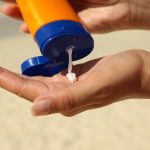Sunscreen DRASTICALLY reduces vitamin D3 production, studies suggest
 (NaturalHealth365) For over two decades, we have been warned about the “dangers of sun exposure.” Yet, while a sunburn can indeed have negative health effects, the truth is that the sun is our best source of vitamin D – particularly vitamin D3. In fact, new research published in Clinical Nutrition suggests that higher vitamin D levels lower the risk of premature death from all causes, heart disease, and cancer, highlighting the importance of maintaining adequate vitamin D levels for a longer, healthier life.
(NaturalHealth365) For over two decades, we have been warned about the “dangers of sun exposure.” Yet, while a sunburn can indeed have negative health effects, the truth is that the sun is our best source of vitamin D – particularly vitamin D3. In fact, new research published in Clinical Nutrition suggests that higher vitamin D levels lower the risk of premature death from all causes, heart disease, and cancer, highlighting the importance of maintaining adequate vitamin D levels for a longer, healthier life.
Sadly, most people don’t realize that sunscreen products – as low as SPF 15 – actually block the production of crucial vitamin D3 by 99 percent or more. A clinical study by the American Osteopathic Association has found that up to 1 billion people worldwide have insufficient vitamin D levels. Researchers speculate that it is due to a lack of sun exposure – which is the body’s primary source of vitamin D.
With such widespread campaigning to encourage people to wear sunscreen every time they leave their homes, we are not receiving the healthy, nourishing rays that are crucial to immune system health and other bodily processes.
Sunscreen and modern living conditions to blame for insufficient sun exposure
The clinical review published in The Journal of the American Osteopathic Association determined that 95 percent of African Americans also suffer from a vitamin D deficiency. While there can be variations due to skin pigmentation, not receiving enough sunlight can affect any human being.
In addition to wearing sunscreen, people are also just generally not spending as much time outdoors as they once did. Both young people and adults are more often staying indoors to watch TV, use their computers and other devices, or play video games instead of going outside.
Vitamin D3 supplementation can help prevent infection, MS, Alzheimer’s disease and cancer
Vitamin D receptors are found on nearly every cell of the body. Vitamin D is actually a hormone that’s triggered into production when the skin is exposed to sunlight. It plays a major role in numerous bodily functions, including cell growth, reducing inflammation, neuromuscular functioning, and immune system functioning.
Chronic diseases such as type 2 diabetes exacerbate vitamin D deficiency, which is also fueled by conditions that inhibit vitamin D absorption, such as kidney disease, celiac disease, and Crohn’s disease. Vitamin D deficiency has been linked to autoimmune disorders, infection, multiple sclerosis, cardiometabolic disease, respiratory disease, cancer, Alzheimer’s disease, and other forms of dementia.
Sun exposure and vitamin D supplementation are crucial to achieving ideal blood levels
As you may know, symptoms of vitamin D deficiency include bone fractures and muscle weakness. The best way to verify vitamin D levels is with a blood test. Vitamin D levels below 30 ng/ml are considered an insufficiency, and a deficiency refers to less than 20/ml, according to the Endocrine Society. However, holistic doctors often recommend higher levels, typically 60 to 80 ng/ml, for optimal health.
Getting enough vitamin D can be as simple as spending 5 to 30 minutes in the sun at midday two to three times per week. However, ideal amounts of time may vary depending on skin tone and geographic location.
In conclusion, minimize your use of sunscreen, as this may block the nourishing and health-sustaining elements of the sun. And, finally, another helpful tip: eat foods rich in vitamin D, like wild-caught sardines, salmon, and cod liver oil, to help boost blood levels of this crucial hormone.
Editor’s note: Discover the many ways to naturally improve immune system function, own the Immune Defense Summit created by NaturalHealth365 Programs.
Sources for this article include:



